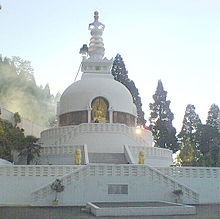
A pagoda is an Asian tiered tower with multiple eaves common to Thailand, Nepal, China, Japan, Korea, Myanmar, Vietnam, and other parts of Asia. Most pagodas were built to have a religious function, most often Buddhist but sometimes Taoist, and were often located in or near viharas. The pagoda traces its origins to the stupa while its design was developed in ancient Nepal.

The Longhua Temple is a Buddhist temple dedicated to the Maitreya Buddha in Shanghai. Although most of the present day buildings date from later reconstructions, the temple preserves the architectural design of a Song dynasty (960–1279) monastery of the Chan School. It is the largest ancient temple complex in the city of Shanghai.

The Kek Lok Si Temple is a Buddhist temple situated in Air Itam, Penang, Malaysia. It is the largest Buddhist temple in Malaysia, and is also an important pilgrimage centre for Buddhists from Hong Kong, the Philippines, Singapore and other countries in Southeast Asia. The entire complex of temples was built over a period from 1890 to 1930, an inspirational initiative of Beow Lean, the abbot. The main draw in the complex is the striking seven-storey Pagoda of the late Thai king Rama VI, which structure is known as the pagoda of Ten Thousand Buddhas with 10,000 alabaster and bronze statues of Buddha, and the 36.57-metre-tall (120 ft) bronze statue of Guanyin, the Goddess of Mercy. The 10.000 Buddhas concept belongs to the Chinese Mahāyāna school of Buddhism while Rama VI was king over a Theravāda country and Buddhist tradition.
Nipponzan-Myōhōji-Daisanga (日本山妙法寺大僧伽), often referred to as just Nipponzan Myohoji or the Japan Buddha Sangha, is a Japanese new religious movement and activist group founded in 1917 by Nichidatsu Fujii, emerging from Nichiren Buddhism. "Nipponzan Myōhōji is a small Nichiren Buddhist order of about 1500 persons, including both monastics and lay persons." The community reveres the Lotus Sutra as the highest expression of the Buddhist message.
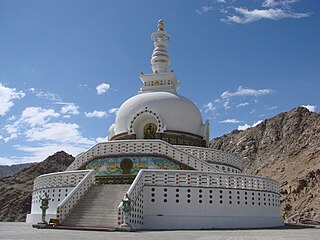
A Peace Pagoda is a Buddhist stupa; a monument to inspire peace, designed to provide a focus for people of all races and creeds, and to help unite them in their search for world peace. Most, though not all, peace pagodas built since World War II have been built under the guidance of Nichidatsu Fujii (1885–1985), a Buddhist monk from Japan and founder of the Nipponzan-Myōhōji Buddhist Order. Fujii was greatly inspired by his meeting with Mahatma Gandhi in 1931 and decided to devote his life to promoting non-violence. In 1947, he began constructing Peace Pagodas as shrines to world peace. The first was inaugurated at Kumamoto in 1954.
Nichidatsu Fujii was a Japanese Buddhist monk, and founder of the Nipponzan-Myōhōji order of Buddhism. He is best known for his decision in 1947 to begin constructing Peace Pagodas in many locations around the world as shrines to world peace.

Kumamoto is the capital city of Kumamoto Prefecture on the island of Kyushu, Japan. As of June 1, 2019, the city has an estimated population of 738,907 and a population density of 1,893 people per km2. The total area is 390.32 km2.

The Guoqing Temple is a Buddhist temple on Mount Tiantai, in Taizhou, Zhejiang Province, China. Originally built in 598 CE during the Sui dynasty, and renovated during the reign of the Qing Yongzheng Emperor, the temple is located roughly 220 kilometres (140 mi) from the city of Hangzhou. It was the initial site for the creation of the Tiantai school of Mahāyāna Buddhism, founded by the Chinese Buddhist teacher Zhiyi. The temple covers an area of some 23,000 m2 (250,000 sq ft) and features 600 rooms in a total of 14 different halls, including the Grand Hall of Sakyamuni, the Hall of Five Hundred Arhats and the Hall of Monk Jigong. The exterior of the building features Chinese pagodas such as the Sui Pagoda, the Seven Buddha Pagoda, and the Memorial Pagoda of Monk Yi Xing.
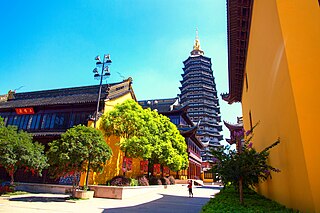
The Tianning Temple, is a Buddhist temple located in Changzhou City, Jiangsu Province, China, is noted for its giant pagoda, the Tianning Pagoda (天宁宝塔/天寧宝塔). Construction began in April 2002 with the opening ceremony for the completed structure held on April 30, 2007, where a crowd of hundreds of Buddhist monks gathered for the ceremony. With 13 stories and a height of 153.79 metres (505 ft), this is now the tallest pagoda in the world, taller than China's tallest existent pre-modern Buddhist pagoda, the Liaodi Pagoda built in 1055 at a height of 84 m (275 ft). Although the existing pagoda was built by April 2007, the temple grounds and the pagoda have a history of construction and destruction for the past 1,350 years, since the time of the Tang dynasty (618–907). Building of the pagoda was proposed by the Buddhist Association of China in 2001, yet providing money donations for the temple was an international effort, as leaders of 108 Buddhist associations and temples worldwide attended the opening ceremony at the temple.

Shanti Stupa is a Buddhist white-domed Stupa (chorten) on a hilltop in Chanspa, Leh district, Ladakh, in north India. It was built in 1991 by Japanese Buddhist Bhikshu, Gyomyo Nakamura. The Shanti Stupa holds the relics of the Buddha at its base, enshrined by the 14th Dalai Lama. The Stupa has become a tourist attraction not only due to its religious significance but also due to its location which provides panoramic views of the surrounding landscape.

Pokhara Shanti Stupa is a Buddhist monument on Anadu Hill of the former Pumdi Bhumdi Village Development Committee, in the district of Kaski, Nepal.

Junsei Terasawa is a Japanese Buddhist monk, belonging to the Order Nipponzan Myōhōji. He is notable for being the first Nipponzan monk to be active in Eurasia.
Kōsen-rufu (広宣流布), a phrase found in the Japanese translation of the Buddhist scripture Lotus Sutra, is informally defined to as "world peace through individual happiness." It refers to the future widespread dissemination of the Lotus Sutra.

The New England Peace Pagoda is a peace pagoda located in Leverett, Massachusetts. It was the first Nipponzan-Myōhōji peace pagoda to be built in the United States.
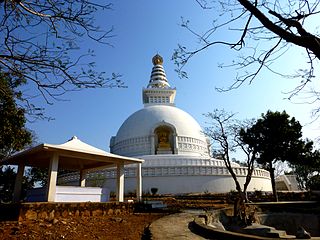
Vishwa Shanti Stupa is a large white Peace Pagoda in Rajgir, Nalanda District, Bihar, near Gitai Mandir. Statues of the Buddha are mounted on the stupa in four directions. It also has a small Japanese Buddhist temple with a large park. There is a temple near the stupa where prayers are conducted for universal peace. The initial pagoda was completed in 1969. New initiatives in 1993 resulted in the present form. It is one of around 80 Peace Pagodas which have been built around the world by the neo-Buddhist organisation Nipponzan Myohoji. These were a dream of Nichidatsu Fujii, inspired by Mohandas K. Gandhi, as a reaction to the atomic bombing of Japan, the first, and more well known Vishwa Shanti stupa, being built on Ratnagiri Hill in Rajgir.
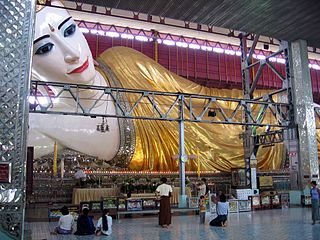
Chaukhtatgyi Buddha Temple is the most well-known Buddhist temple in Bahan Township, Yangon, Yangon Region, Myanmar. It houses one of the most revered reclining Buddha images in the country. The Buddha image is 66 metres (217 ft) long, and one of the largest in Burma.

Caotang Temple is a Buddhist temple located on the north hillside of Mount Guifeng, in Huyi District of Xi'an, Shaanxi, China.

Lingguang Temple is a Buddhist temple located on the east hillside of Mount Cuiwei (翠微山), in the Shijingshan District of Beijing. The temple is renowned for its collection of the tooth relic of the Buddha.

World Peace Pagoda, also called Nipponzan Peace Pagoda, is a Buddhist monument in Lumbini, Nepal. It was designed and built by Japanese Buddhists at a cost about a million US dollars. The Pagoda acts as the starting point on the central axis of the Lumbini Master Plan, the other end being the Mayadevi Temple. The distance from the pagoda to the temple is about 3.2 km. The stairs in stupa lead to three different levels. The stupa is whitewashed and the floor is stone-paved. It has four large golden statues of Buddha facing four directions.

Shanti Stupa is a Buddhist monument in Delhi, India, intended as "a symbol of universal brotherhood and peace." It is one of several Peace Pagodas in the world. Started by the Nipponzan-Myōhōji-Daisanga religious order of Buddhism, it was inaugurated by the Dalai Lama on 4 November 2007.
